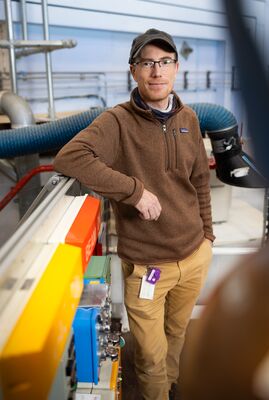Glasses are formed by cooling liquids from high temperatures until they solidify without crystallising. During this process, the material’s viscosity increases by around 15 orders of magnitude, a factor of one quadrillion. Despite such an enormous change in flow behaviour, the underlying molecular-scale structural changes are often subtle and difficult to observe directly.
Understanding these atomic rearrangements is key to improving how glasses are designed and manufactured, especially for demanding applications such as solid oxide fuel cells, optical devices, and nuclear waste encapsulation.
 Using neutron diffraction on the SANDALS instrument at ISIS, beamline scientist Oliver Alderman studied the temperature-dependent structure of barium borosilicate glass, a widely used industrial material. Neutrons are particularly sensitive to light elements like boron and oxygen, making them ideal for probing the atomic arrangement within complex glasses that also contain heavier elements such as barium.
Using neutron diffraction on the SANDALS instrument at ISIS, beamline scientist Oliver Alderman studied the temperature-dependent structure of barium borosilicate glass, a widely used industrial material. Neutrons are particularly sensitive to light elements like boron and oxygen, making them ideal for probing the atomic arrangement within complex glasses that also contain heavier elements such as barium.
As the glass was heated through its glass transition temperature (901 K), the data revealed a distinct change in the bonding environment of boron atoms. Specifically, boron atoms gradually transitioned from being tetrahedrally coordinated bonded to four oxygen atoms to trigonally coordinated bonded to three.
This shift indicates a process known as depolymerisation, where the atomic network becomes less connected as the glass melts. During cooling, the opposite occurs, repolymerisation which rebuilds the network and contributes to the dramatic thickening of the liquid as it turns into a glass.
These findings provide direct experimental evidence of how atomic-scale bonding changes govern the macroscopic behaviour of glass-forming liquids. The ability to quantify boron coordination with temperature helps explain the relationship between structure, viscosity, and heat capacity, which are central to glass science.
Beyond its fundamental importance, this research has clear technological implications. A deeper understanding of how borosilicate glasses evolve during heating and cooling will aid in the design of more durable, thermally stable materials for high-temperature applications from energy technologies to industrial manufacturing.
Read the full paper : Tracking boron coordination change with temperature in a barium borosilicate glass melt by neutron diffraction | Phys. Rev. Materials
